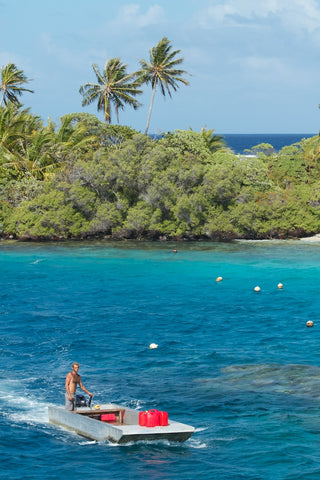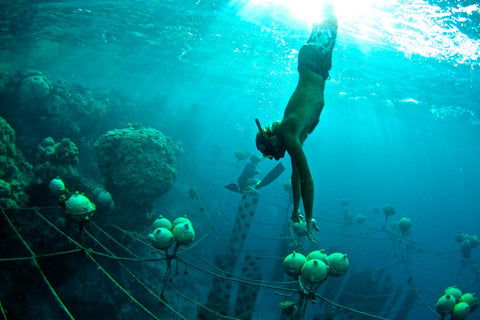Not an Island At-oll

Josh's favorite pun is that an "atoll" isn't an island "at all." And it's true. These tropical rings of coral glow dull amber, white and green around brilliant turquoise lagoons and are comprised mostly of the seawater they envelop, not their sandy, dead coral-strewn land. There are 120 of these beauties in French Polynesia's Tuamotu Archipelago and hundreds more are scattered across Polynesia and the world's tropical seas.
The first time I came to Ahe I had no idea that atolls looked anything like this. I'd heard of them in geology class, but those descriptions had left me with a fuzzy image of a lush high island with a hole in the middle, not these flat, shrubby, amorphous shaped rings. It was as if my education had duped me: why didn't we learn more about atolls in school? Why aren't there pictures of these paradises up in every travel agent's office around the planet? It astounds me that most people will never get to see an atoll and that I could easily have missed them too. In my opinion atolls are one of the most beautiful geologic formations on Earth.

Charles Darwin must have been equally awed when he voyaged to the Coco and Keeling Atolls in the Indian Ocean in 1836 aboard the H.M.S Beagle. On this voyage Darwin theorized that these ring-shaped "islands" are the barrier reefs that once surrounded volcanic high islands that sank and eroded into the lagoon over hundreds of thousands of years.
The process according to Darwin goes like this: An island is formed by a volcano. Over millennium, coral reef grows on the island's underwater slope. Once the reef has built up to near the surface, pieces break off and pile up on top of each other during storms and big swells. This creates dry land that peeks out above the surface of the highest tides. This broken, dead coral breaks down into sand and limestone cement that creates a hard land surface called a "cay" in English. Eventually small islets are formed in a linked chain with shallow waterways between them. Water flows in and out of the waterways, called hoa in Tahitian, from the ocean to the lagoon. When a waterway is deep enough to be navigable by boat, it's called a pass. Meanwhile the volcanic island in the middle slowly sinks and erodes till it disappears completely into the lagoon. The whole geologic process from volcano to atoll apparently takes around 30 billion years.

This theory sounded a bit far out to other scientists back in the 1800s and other theories of how these bizarre circular islands formed were argued about in institutions of higher learning for about 100 years. Then in 1951, during the era of nuclear testing, the American-run Atomic Energy Commission in the Marshall Islands drilled down 4154 feet under Eniwetok Atoll. They hit volcanic rock. Yup, there was an island under there and Darwin was proved right. Having lived on an atoll I can also back Darwin up: every time a big swell hits Ahe massive chunks of dead coral are thrown up onto the reef and far inland creating more landmass.

But atoll formation doesn't end with coral and rock. While the atoll is forming and becoming landmass, seeds floating through the ocean wash ashore and sprout vegetation in the sand. Sea birds come to nest, leaving guano (a powerful fertilizer) that mixes with the decayed shrubs and sand to create dirt. In reality, even after these natural processes, most islets on atolls have terrible - if any - soil but there are usually a few vaguely fertile islets where plants can actually thrive. Our motu on Ahe has little soil or sand and is covered mostly with coral gravel, coconut palms and local shrubs. It wouldn't have been habitable for humans in the days before supply ships.

Despite its inhospitable aspects for gardening, atolls are ideal for farming oysters and thus, culturing pearls. Oysters thrive in a nutrient-poor environment so the lack of soil and minerals draining into their water is a boon. The remoteness of Ahe and the small human population means the water is also clean and pure. The atoll acts as an enclosure from the ocean that makes it possible to hang lines, build structures and farm. While the lagoon can get rough, it's nothing compared to the swells and storms in the ocean ocean so our atoll acts like a protected nest where we can create our beautiful gems from the sea.
Text by Celeste Brash, photos by Josh Humbert, copyright 2016
Please ask for permission to use text or photos. Thanks!

Lots of interesting and educational information here. Thanks!
Very interesting! And the pictures are beautiful.